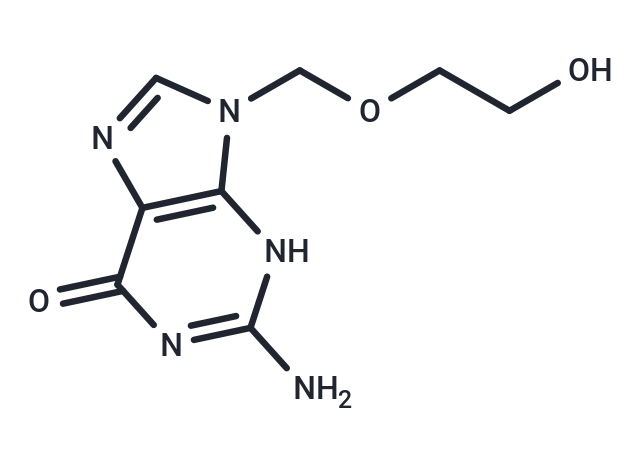Shopping Cart
Remove All Your shopping cart is currently empty
Your shopping cart is currently empty
Acyclovir (Aciclovir) is a synthetic analog of the purine nucleoside, guanosine, with potent antiviral activity against herpes simplex viruses type 1 and 2, varicella-zoster virus and other viruses of the herpesvirus family.

| Pack Size | Price | USA Warehouse | Global Warehouse | Quantity |
|---|---|---|---|---|
| 25 mg | $39 | In Stock | In Stock | |
| 50 mg | $51 | In Stock | In Stock | |
| 100 mg | $80 | In Stock | In Stock | |
| 200 mg | $104 | In Stock | In Stock | |
| 500 mg | $131 | In Stock | In Stock | |
| 1 mL x 10 mM (in DMSO) | $50 | In Stock | In Stock |
| Description | Acyclovir (Aciclovir) is a synthetic analog of the purine nucleoside, guanosine, with potent antiviral activity against herpes simplex viruses type 1 and 2, varicella-zoster virus and other viruses of the herpesvirus family. |
| Targets&IC50 | HSV1:0.85 μM (IC50), HSV2:0.86 μM (IC50) |
| In vitro | Acyclovir sensitivity of herpes simplex virus isolates is determined in a plaque-reduction assay in Vero cells. IC50 Values are consistently 2-3 fold lower in B2 compared with the H strain of Vero cells. HSV Type 2 strains are 2-10-fold less sensitive than Type 1 strains[2]. |
| In vivo | low-dose oral acyclovir may be effective in the prevention of HSV infection during OKT3 treatment of seropositive patients. Continuation of acyclovir prophylaxis for two to four weeks following the conclusion of OKT3 therapy may prevent occurrence of delayed infections[3]. |
| Kinase Assay | Total AMPK activity is measured using the method of Dagher et al. AMPK activity is quantified in the resuspended pellet as incorporation of?32P from [γ-32P]ATP (10 GBq/mmol) into a synthetic peptide with the specific target sequence for AMPK, the SAMS peptide. Radioactivity is measured using a liquid scintillation counter. Protein content in the solution containing the resupended (NH4)2SO4 pellet is determined using the Bradford method. |
| Synonyms | Acycloguanosine, Aciclovir |
| Molecular Weight | 225.2 |
| Formula | C8H11N5O3 |
| Cas No. | 59277-89-3 |
| Smiles | NC1=NC(=O)C2=C(N1)N(COCCO)C=N2 |
| Relative Density. | 1.77 |
| Color | White |
| Appearance | Solid |
| Storage | Powder: -20°C for 3 years | In solvent: -80°C for 1 year | Shipping with blue ice/Shipping at ambient temperature. | |||||||||||||||||||||||||||||||||||
| Solubility Information | DMSO: 42.92 mg/mL (190.59 mM), Sonication is recommended. Ethanol: < 1 mg/mL (insoluble or slightly soluble) | |||||||||||||||||||||||||||||||||||
| In Vivo Formulation | 10% DMSO+40% PEG300+5% Tween 80+45% Saline: 2 mg/mL (8.88 mM), Sonication is recommended. Please add the solvents sequentially, clarifying the solution as much as possible before adding the next one. Dissolve by heating and/or sonication if necessary. Working solution is recommended to be prepared and used immediately. The formulation provided above is for reference purposes only. In vivo formulations may vary and should be modified based on specific experimental conditions. | |||||||||||||||||||||||||||||||||||
Solution Preparation Table | ||||||||||||||||||||||||||||||||||||
DMSO
| ||||||||||||||||||||||||||||||||||||
| Size | Quantity | Unit Price | Amount | Operation |
|---|

Copyright © 2015-2025 TargetMol Chemicals Inc. All Rights Reserved.